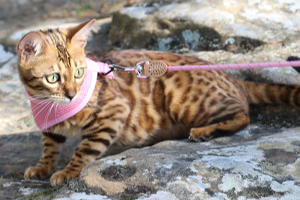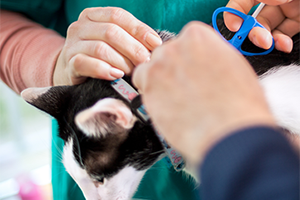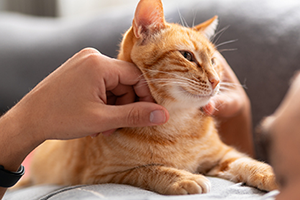If you’re determined to try to lead-train a kitten, these tips should make it easier and less stressful for both of you.
1. Start young
A cat is more likely to be willing to go for walks with a harness if they’re used to it from kittenhood. You can start to familiarise your kitten with wearing a harness from a few months old.
2. Pick the best kitten harness
Choose a kitten harness and lead set that’s lightweight, comfortable and fits snugly without being too tight. Ensure your kitten can move freely and you can fit two fingers between their body and the harness. Don’t attach a lead directly to your kitten’s collar, as this increases the risk of injury or escape.
3. Introduce your cat to the harness
Leave the harness near your kitten’s bed or bowl for several days so they get used to it before you try it on them. Never leave a lead lying around though, as it’s a strangulation hazard. Encourage your kitten to investigate the harness and reward the kitten for choosing to approach the harness. Repeat this step many times!
4. Practise indoors first
Start by trying the harness indoors for a few seconds and then remove it and immediately reward with a treat. If your kitten tries to struggle or flop on one side, then the process is going too quickly. Use treats and affection consistently so they develop positive associations with the harness and gradually build up to wearing it for longer periods.
5. Be patient
It may take your kitten weeks or even months to get used to a harness, and many will never tolerate one. Don’t rush the process and allow your kitten to set the pace.
6. Be prepared
Even if on a lead, your kitten should be vaccinated, microchipped and neutered before you take them outside, in case they escape or encounter other cats.
7. Choose the right spot
Pick a quiet outdoor space with plenty of hiding places, where your kitten won’t be startled by cars, dogs or other cats. A private garden with no other pets is preferable to a public park or street.
8. Carry your kitten
Carry your kitten to wherever you want to walk them. If you let them walk from the front door, they may be more likely to dash out when you don’t want them to in the future.
9. Don’t expect dog-like behaviour from a cat
Walking a kitten is very different to walking a dog. A kitten won’t walk to heel or necessarily go where you want to, and they won’t go to the toilet while on a lead. It’s more a case of the cat walking you – if they want to chew grass or lie in the sun, you’ll just have to wait for them!
10. Don’t force it
Never force your kitten to wear a harness or go for a walk – you run the risk of them (and you!) being traumatised or injured. If your pet shows any sign of discomfort or distress, stop and head home.















